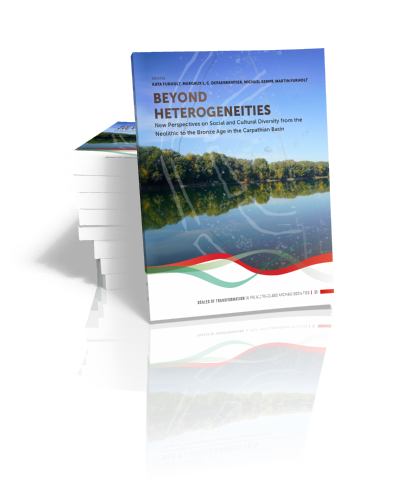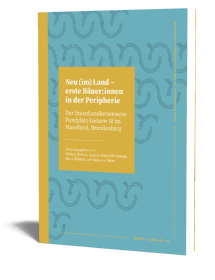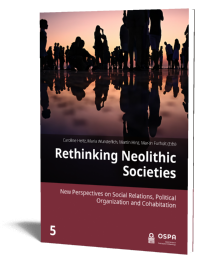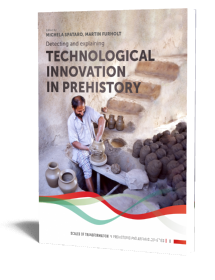Beyond heterogeneities
New perspectives on social and cultural diversity from the Neolithic to the Bronze Age in the Carpathian Basin
Edited by Kata Furholt, Margaux L. C. Depaermentier, Michael Kempf & Martin Furholt | Forthcoming

Beyond heterogeneities
New perspectives on social and cultural diversity from the Neolithic to the Bronze Age in the Carpathian Basin
Edited by Kata Furholt, Margaux L. C. Depaermentier, Michael Kempf & Martin Furholt | Forthcoming
Paperback ISBN: 9789464271119 | Hardback ISBN: 9789464271126 | Imprint: Sidestone Press Academics | Format: 210x280mm | ca. 376 pp. | Scales of Transformation 21 | Series: Scales of Transformation | Language: English | 15 illus. (bw) | 144 illus. (fc) | Keywords: European archaeology; Neolithic; Bronze Age; Carpathian Basin; settlement structure; social organisation; burial practices; demography; enclosure ditches; landscape archaeology; magnetic prospection; social inequality | download cover | DOI: 10.59641/vl0230ox
Publication date: 26-03-2025
-
Digital & Online access
Digital/Online version not (yet) available
-
Buy via Sidestone (EU & UK)
Get €5.00 discount on forthcoming books by using coupon code "PRE-ORDER" in your shopping cart!
-
Buy via our Distributors (WORLD)
For non-EU or UK destinations you can buy our books via our international distributors. Although prices may vary this will ensure speedy delivery and reduction in shipping costs or import tax. But you can also order with us directly via the module above.
For UK & other International destinations
For USA/Canada & other International destinations
-
Bookinfo
Paperback ISBN: 9789464271119 | Hardback ISBN: 9789464271126 | Imprint: Sidestone Press Academics | Format: 210x280mm | ca. 376 pp. | Scales of Transformation 21 | Series: Scales of Transformation | Language: English | 15 illus. (bw) | 144 illus. (fc) | Keywords: European archaeology; Neolithic; Bronze Age; Carpathian Basin; settlement structure; social organisation; burial practices; demography; enclosure ditches; landscape archaeology; magnetic prospection; social inequality | download cover | DOI: 10.59641/vl0230ox
Publication date: 26-03-2025

We will plant a tree for each order containing a paperback or hardback book via OneTreePlanted.org.
This volume presents various facets of recent archaeological investigations into Neolithic and Bronze Age societies in the Carpathian Basin spanning from the 7th and 2nd millennium BCE. It delves into population dynamics, settlement patterns, and the spread of the Neolithic way of life through methodological approaches such as demographic analysis and environmental modelling.
Moreover, the book explores social transformations and the development of inequalities, emphasizing the role of cultural complexes and technological advancements in shaping prehistoric societies. Interdisciplinary studies encompassing the spatial scales from the archaeological site up to the supra-regional level shed new light on domestic practices, subsistence strategies, and integration into regional socio-economic networks. Several contributions deal with enclosures and communal areas, which are reinterpreted to unveil their ritual significance and community dynamics. This is particularly evident in those cases that include burials. Ritual practices surrounding burial sites are seen as responses to social crises and complex situations, reflecting the negotiation of individuality and community identity.
Overall, the book underscores the multifaceted nature of Neolithic and Bronze Age societies, showcasing their adaptability, social complexity, and elaborate interactions with the environment and neighbouring communities.
Preface of the Series Editors
Wiebke Kirleis, Johannes Müller
Introduction
Kata Furholt, Margaux L. C. Depaermentier, Michael Kempf, Martin Furholt
PART 1. POPULATION AND SETTLEMENT DYNAMICS
Starčevo-Körös-Criş regional and macro-regional palaeo-demography
Tamara Blagojević, Marko Porčić, Sofija Stefanović
Exploring Neolithic site preferences in the river Tisza floodplain using point pattern analysis and multicomponent environmental models
Michael Kempf, Gerrit Günther, Margaux L. C. Depaermentier
The possible effect of plant cover on wind comfort in the Late Neolithic: a case study using environmental reconstruction for the site of Makaranda (northern Serbia)
Aleksandar Medović, Robert Hofmann, Martin Furholt, Tijana Stanković Pešterac, Ildiko Medović, Stefan Dreibrodt, Liudmyla Shatilo, Kata Furholt, Fynn Wilkes, Darko Radmanović, Nikola Mrkšić
Neolithic settlement structures on the lower reaches of the Tisza River, Vojvodina, Serbia: the results of archaeo-magnetic prospection
Robert Hofmann, Kata Furholt, Aleksandar Medović, Martin Furholt, Fynn Wilkes, Ildiko Medović, Tijana Stanković Pešterac, Till Kühl, Sebastian Schultrich, Raško Ramadanski, Lenkskaya Martinova
Szegvár-Tűzköves (Tisza region, Hungary): teaching an old site new tricks
Pál Raczky, András Füzesi, Gábor Mesterházy, Kata Furholt, Eszter Bánffy, Knut Rassmann, Máté Stibrányi, Gábor Serlegi
PART 2. SOCIAL TRANSFORMATIONS AND INEQUALITIES
Social transformations of liminal areas in the Late Neolithic: a multidisciplinary approach to the site of Gradište (Serbia)
Miroslav Marić, Silvia Amicone, Jelena Bulatović, Nemanja Marković, Neda Mirković Marić
Circuits of reproduction: The opportunities and power to change
Tamás Polányi
Applying the Inequality Possibility Frontier and the Inequality Extraction Ratio to archaeological data: studying inequality in the Early Bronze Age cemetery of Jelšovce (Slovakia)
Fynn Wilkes, Henry Skorna
PART 3. ENCLOSURE AND COMMUNAL AREAS
Understanding the variability of deposition practices involving human remains in Neolithic settlements of the northern Carpathian Basin: the Neolithic site of Vráble (Nitra district, Slovakia)
Martin Furholt, Ivan Cheben
Exploring the Late Neolithic ditch: new data on dating, subsistence and environment from a circular enclosure at Borđoš, Vojvodina, Serbia
Robert Hofmann, Aleksandar Medović, Slobodan B. Marković, György Sipos, Sarah Pleuger-Dreibrodt, Rundall A. Schaetzl, Milivoj B. Gavrilov, Milica G. Radaković, Ildiko Medović, Desanka Kostić, Stefan Dreibrodt, Fynn Wilkes, Tijana Stanković Pešterac, Martin Furholt
PART 4. ECONOMY AND SUBSISTENCE STRATEGIES
Animal economy of the Lengyel Culture population in Slovakia and the case study of Kiarov
Noémi Beljak Pažinová, Katarína Šimunková, Alena Bistáková
Continuity in lithic tool production and raw material use at the Neolithic site of Karancsság, in the North-Hungarian Mountains (Nógrád county, Hungary)
Kata Furholt
Social and cultural diversity in the later prehistory of the Carpathian Basin: some implications
Eszter Bánffy
Dr. Kata Furholt
Kata Furholt is a research fellow and lecturer at Kiel University (CAU) in Germany. Since 2021, she has been working on the XSCAPE project (ERC Synergy grant) where she studies materiality in Prehistoric Societies with special attention to burial practices and how they relate to the objects and the body in the grave context in the light of the visuospatial perception.
Dr. Michael Kempf
Michael earned Master’s degrees in Geography, Geology, Meteorology (2010) and Archaeology (2018) from the University of Freiburg. He successfully completed his PhD (Dr. rer. nat.) in Physical Geography at the same institution in June 2020. In the spring of 2020, he secured a two-year post-doctoral fellowship, funded by the European Union, at the Department of Archaeology and Museology at Masaryk University in Brno, Czech Republic. Following this, he took on the role of a Visiting Scholar at the McDonald Institute for Archaeological Research at the University of Cambridge.
Dr. Margaux L. C. Depaermentier
Margaux L. C. Depaermentier’s academic career began with a Bachelor of Arts degree in Art History and Archaeology at the Université Paris I Panthéon-Sorbonne (France), followed by a Master of Arts degree in Early Medieval and Medieval Archaeology at the Alberts-Ludwigs-Universität in Freiburg (Germany). She obtained her PhD at the University of Basel (Switzerland), where her dissertation, “Late Antique and Early Medieval Social Structure in Basel from an Archaeological and Scientific Perspective,” advanced our understanding of Late Antique and Early Medieval societies in this border region.

Prof. Dr. Martin Furholt
Martin Furholt is Professor of Social Archaeology at Kiel University. His main research interests are the political dimension of social organisation in the past, and prehistoric mobility during the Neolithic and Bronze Age periods in Europe. He is currently conducting fieldwork on 6th and 5th millennium BCE Neolithic settlement in Slovakia and Serbia, and publishes papers related to the ongoing 3rd millennium migration debate in Europe.
Abstract:
This volume presents various facets of recent archaeological investigations into Neolithic and Bronze Age societies in the Carpathian Basin spanning from the 7th and 2nd millennium BCE. It delves into population dynamics, settlement patterns, and the spread of the Neolithic way of life through methodological approaches such as demographic analysis and environmental modelling.
Moreover, the book explores social transformations and the development of inequalities, emphasizing the role of cultural complexes and technological advancements in shaping prehistoric societies. Interdisciplinary studies encompassing the spatial scales from the archaeological site up to the supra-regional level shed new light on domestic practices, subsistence strategies, and integration into regional socio-economic networks. Several contributions deal with enclosures and communal areas, which are reinterpreted to unveil their ritual significance and community dynamics. This is particularly evident in those cases that include burials. Ritual practices surrounding burial sites are seen as responses to social crises and complex situations, reflecting the negotiation of individuality and community identity.
Overall, the book underscores the multifaceted nature of Neolithic and Bronze Age societies, showcasing their adaptability, social complexity, and elaborate interactions with the environment and neighbouring communities.
Contents
Preface of the Series Editors
Wiebke Kirleis, Johannes Müller
Introduction
Kata Furholt, Margaux L. C. Depaermentier, Michael Kempf, Martin Furholt
PART 1. POPULATION AND SETTLEMENT DYNAMICS
Starčevo-Körös-Criş regional and macro-regional palaeo-demography
Tamara Blagojević, Marko Porčić, Sofija Stefanović
Exploring Neolithic site preferences in the river Tisza floodplain using point pattern analysis and multicomponent environmental models
Michael Kempf, Gerrit Günther, Margaux L. C. Depaermentier
The possible effect of plant cover on wind comfort in the Late Neolithic: a case study using environmental reconstruction for the site of Makaranda (northern Serbia)
Aleksandar Medović, Robert Hofmann, Martin Furholt, Tijana Stanković Pešterac, Ildiko Medović, Stefan Dreibrodt, Liudmyla Shatilo, Kata Furholt, Fynn Wilkes, Darko Radmanović, Nikola Mrkšić
Neolithic settlement structures on the lower reaches of the Tisza River, Vojvodina, Serbia: the results of archaeo-magnetic prospection
Robert Hofmann, Kata Furholt, Aleksandar Medović, Martin Furholt, Fynn Wilkes, Ildiko Medović, Tijana Stanković Pešterac, Till Kühl, Sebastian Schultrich, Raško Ramadanski, Lenkskaya Martinova
Szegvár-Tűzköves (Tisza region, Hungary): teaching an old site new tricks
Pál Raczky, András Füzesi, Gábor Mesterházy, Kata Furholt, Eszter Bánffy, Knut Rassmann, Máté Stibrányi, Gábor Serlegi
PART 2. SOCIAL TRANSFORMATIONS AND INEQUALITIES
Social transformations of liminal areas in the Late Neolithic: a multidisciplinary approach to the site of Gradište (Serbia)
Miroslav Marić, Silvia Amicone, Jelena Bulatović, Nemanja Marković, Neda Mirković Marić
Circuits of reproduction: The opportunities and power to change
Tamás Polányi
Applying the Inequality Possibility Frontier and the Inequality Extraction Ratio to archaeological data: studying inequality in the Early Bronze Age cemetery of Jelšovce (Slovakia)
Fynn Wilkes, Henry Skorna
PART 3. ENCLOSURE AND COMMUNAL AREAS
Understanding the variability of deposition practices involving human remains in Neolithic settlements of the northern Carpathian Basin: the Neolithic site of Vráble (Nitra district, Slovakia)
Martin Furholt, Ivan Cheben
Exploring the Late Neolithic ditch: new data on dating, subsistence and environment from a circular enclosure at Borđoš, Vojvodina, Serbia
Robert Hofmann, Aleksandar Medović, Slobodan B. Marković, György Sipos, Sarah Pleuger-Dreibrodt, Rundall A. Schaetzl, Milivoj B. Gavrilov, Milica G. Radaković, Ildiko Medović, Desanka Kostić, Stefan Dreibrodt, Fynn Wilkes, Tijana Stanković Pešterac, Martin Furholt
PART 4. ECONOMY AND SUBSISTENCE STRATEGIES
Animal economy of the Lengyel Culture population in Slovakia and the case study of Kiarov
Noémi Beljak Pažinová, Katarína Šimunková, Alena Bistáková
Continuity in lithic tool production and raw material use at the Neolithic site of Karancsság, in the North-Hungarian Mountains (Nógrád county, Hungary)
Kata Furholt
Social and cultural diversity in the later prehistory of the Carpathian Basin: some implications
Eszter Bánffy
Dr. Kata Furholt
Kata Furholt is a research fellow and lecturer at Kiel University (CAU) in Germany. Since 2021, she has been working on the XSCAPE project (ERC Synergy grant) where she studies materiality in Prehistoric Societies with special attention to burial practices and how they relate to the objects and the body in the grave context in the light of the visuospatial perception.
Dr. Michael Kempf
Michael earned Master’s degrees in Geography, Geology, Meteorology (2010) and Archaeology (2018) from the University of Freiburg. He successfully completed his PhD (Dr. rer. nat.) in Physical Geography at the same institution in June 2020. In the spring of 2020, he secured a two-year post-doctoral fellowship, funded by the European Union, at the Department of Archaeology and Museology at Masaryk University in Brno, Czech Republic. Following this, he took on the role of a Visiting Scholar at the McDonald Institute for Archaeological Research at the University of Cambridge.
Dr. Margaux L. C. Depaermentier
Margaux L. C. Depaermentier’s academic career began with a Bachelor of Arts degree in Art History and Archaeology at the Université Paris I Panthéon-Sorbonne (France), followed by a Master of Arts degree in Early Medieval and Medieval Archaeology at the Alberts-Ludwigs-Universität in Freiburg (Germany). She obtained her PhD at the University of Basel (Switzerland), where her dissertation, “Late Antique and Early Medieval Social Structure in Basel from an Archaeological and Scientific Perspective,” advanced our understanding of Late Antique and Early Medieval societies in this border region.

Prof. Dr. Martin Furholt
Martin Furholt is Professor of Social Archaeology at Kiel University. His main research interests are the political dimension of social organisation in the past, and prehistoric mobility during the Neolithic and Bronze Age periods in Europe. He is currently conducting fieldwork on 6th and 5th millennium BCE Neolithic settlement in Slovakia and Serbia, and publishes papers related to the ongoing 3rd millennium migration debate in Europe.
-
Digital & Online access
Digital/Online version not (yet) available
-
Buy via Sidestone (EU & UK)
Get €5.00 discount on forthcoming books by using coupon code "PRE-ORDER" in your shopping cart!
-
Buy via our Distributors (WORLD)
For non-EU or UK destinations you can buy our books via our international distributors. Although prices may vary this will ensure speedy delivery and reduction in shipping costs or import tax. But you can also order with us directly via the module above.
For UK & other International destinations
For USA/Canada & other International destinations
- Browse all books by subject
-
Search all books

We will plant a tree for each order containing a paperback or hardback book via OneTreePlanted.org.
You might also like:
© 2025 Sidestone Press KvK nr. 28114891 Privacy policy Sidestone Newsletter Terms and Conditions (Dutch)








